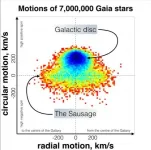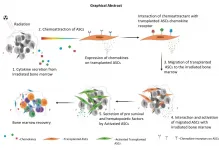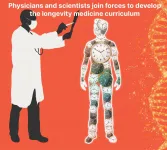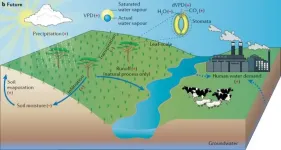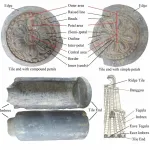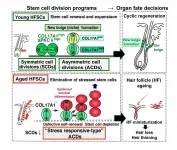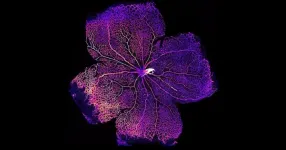Looking up at the starry sky, the deep Universe appears quiet and mysterious. It is hard to imagine that the ancient dwarf galaxy Enceladus violently collided and was torn apart by our own Milky Way Galaxy, leaving behind the cries of a whole new generation of children from the hundred-handed giant. Recently, SCIENCE CHINA: Physics, Mechanics & Astronomy published an (Editor's Focus) article titled "Low-α Metal-rich stars with sausage kinematics in the LAMOST survey: Are they from the Gaia-Sausage-Enceladus Galaxy?" (Vol. 64, No. 3, 2021) co-authored by Gang Zhao and Yuqin Chen, researchers from the National Astronomical Observatories, Chinese Academy of Sciences. The article depicts the tortuous process of how the Gaia-Sausage-Enceladus (GSE) dwarf galaxy mysteriously disappeared in a major merger event that occurred long ago in the early history of the Milky Way, and tells the story of how the authors search for their member stars via a multipath exploration method. Simultaneously, two commentaries by Prof. Yipeng Jing from Shanghai Jiao Tong University and Prof. Zhanwen Han from Yunnan Observatory were published.
Dances with wolves - The Accretion of the GSE by the Milky Way
In the cosmic family, there are massive galaxies such as the Milky Way and Andromeda galaxy, but more numerous are dwarf galaxy members such as Sagittarius, the Magellanic Clouds, and GSE. In its long evolutionary history, the Milky Way has been constantly interacting, colliding, and eventually merging with nearby dwarf galaxies, leading to the formation of many substructures. In 2018, the European Space Agency's Gaia satellite detected the so-called "Gaia-Sausage" structure in velocity space (Figure 1), which is the debris of the GSE dwarf galaxy after "dancing" with the Milky Way. Numerical simulations have revealed that the GSE dwarf galaxy collided head-on with the Milky Way and was buried deep within the Galactic Center 10 billion years ago. The strong impact force in the biggest splash "heated" disk stars up to the Galactic halo, above 4 kpc from the Galactic plane. This is the largest merger event in the Milky Way's ancient history. This discovery is a milestone in the research field of galaxy formation and evolution.
Being towards Death- GSE Merger Brings New Vitality into the Galaxy
After the GSE dwarf galaxy fell into the Milky Way, this family was completely dissolved, and it is hard to find its member stars in space. In search for these missing member stars, Prof. Gang Zhao proposed a multi-path exploration on the GSE debris based on the LAMOST survey, which opened up a new path to find the merging imprints in velocity space, orbital space, and chemical space by combining forces of two large spectral and astrometric surveys. Based on LAMOST and Gaia data, he and his colleague picked out possible GSE member stars in velocity space. Then they adopted chemical abundances as a DNA test for membership identification, since chemical composition does not vary with stellar positions or motions. In total, they identified 1534 low-α metal-rich member stars of GSE among the 8 million stars from the LAMOST data. This is the first discovery of a low-α metal-rich component of the GSE galaxy. Figure 2 shows that this newly discovered component naturally extends from the previously detected metal-poor component.
They calculated spatial distributions and estimated the ages of these member stars. Surprisingly, the stars are young, but reach to 4 kpc above the Galactic plane. Since the GSE merger event happened 10 billion years ago, when these member stars were not even born, it is impossible that the "splash" process could bring disk stars to such high positions. This caused doubt on the previous picture of the GSE merging process. Zhao and Chen suggested that these low-α metal-rich member stars had not undergone the splash process but were newly formed from the metal-rich gas of the GSE merger during subsequent evolution. This suggestion is consistent with the hydro-dynamical simulation by Amarante et al. that produces bimodal disk chemistry. Observationally, this work proves that the GSE dwarf galaxy is a clumpy Milky-Way-like analogue, which updates our understanding of the chemical evolution of the GSE galaxy.
The GSE merger even is essential to the evolution of the Milky Way. It not only brought in GSE member stars with a different chemical composition, but also changed the distribution of stars in the Milky Way. What's more, it brought metal-rich gas and triggered new star formation, radiating new vitality in the Milky Way.
Promising Future--Joining Hands to Build the Milky Way Home and March toward the Andromeda Galaxy
In order to verify the bimodal disk chemistry of the GSE galaxy, the authors studied the distribution in orbital space for GSE metal-rich member stars sharing the same velocity but different chemistry. It is found that both high-α and low-α metal-rich stars exhibit the same clumps and strips as shown in Figure 3, which suggests that they are all accreted from GSE and respond to the Galactic gravitational potential in the same way. Interestingly, the dense strip at Zmax=3-5 kpc forms a clear disk-halo transition at 4 kpc from the Galactic plane.
How did the GSE merger form this transition? This is due to the observational effect caused by the unique speed of the GSE member stars under the influence of the gravitational potential of the Milky Way. Since GSE members have nearly zero rotation and their vertical velocities at Zmax (the highest point in their orbits) are also zero, they spend a longer time at Zmax than at other positions (non-zero velocity), leading to a pile-up of stars at |Z|~ 4 kpc. It's just like cars on the highway. When you're stuck in a traffic jam, the speed is very low, and you can see a lot of cars clustered together, while few cars are shown at a given place where the speed is high. As a large number of GSE member stars have Zmax=3-5 kpc, we observe a high-density region at |Z|~4kpc. Since their radial velocities are neither zero nor identical (see Figure 1), what we see is not a clump, but the long strip shown in Figure 3.
Why can't this disk-halo transition be caused by other dwarf galaxies? The transition depends on not only the velocity characteristics and mass of the dwarf galaxy, but also the mass of the Milky Way and the time when the merger event happened. Because the GSE rotates at zero speed and collides head-on with the Milky Way, as well as continuously responds to the Milky Way's gravitational potential, its member stars show this unique orbital feature. Other dwarf galaxies probably produced clumps elsewhere. For example, the Sagittarius dwarf galaxy merged with the Milky Way at a lower inclination, and their member stars clustered at the apogee of their orbits at about 30 kpc, which is considered to be the transition between the inner and outer halo of the Milky Way. Since other dwarf galaxies do not have the orbital characteristics of the GSE and do not contribute to the |Z|=4 kpc transition, we conclude that it is an imprint left only by the GSE merger event.
For decades 4 kpc has been adopted as the disk-halo transition without knowing the reason of its formation. This is the first time to reveal the physical mechanism by which the GSE merger event causes the apparent separation of the Galactic halo and disk at 4 kpc. It is a true portrayal of the hundred-handed giant's (GSE's) children working together to build our Milky Way home.
Over time, the descendants of the GSE and the Galactic inhabitants merged and became indistinguishable in position, kinematic, and chemical space. Under the attraction of gravity, they march toward the distant Andromeda galaxy. According to the latest numerical simulation, our future generations will be able to witness the spectacular collision of the two large galaxies up close and personal in 4 billion years. Eventually, our Milky Way and Andromeda will merge together to become a new galaxy, but our solar system is expected to survive in this merger event.
The future 2-meter China Space Station Telescope (CSST) has great advantages in the systematic search for imprints left by the GSE and in the study of interactions between the Milky Way and Andromeda galaxy. If you're interested in more stories of galaxy collisions and mergers, stay tuned for further revelations by the CSST project in the future.
INFORMATION:
See the article:
Gang Zhao and Yuqin Chen, "Low-alpha metal-rich stars with sausage kinematics in the LAMOST survey: Are they from the Gaia-Sausage-Enceladus galaxy?", SCIENCE CHINA Physics, Mechanics & Astronomy 64, 239562 (2021); doi: 10.1007/s11433-020-1645-5
https://engine.scichina.com/doi/10.1007/s11433-020-1645-5
Authored by:
CHEN Yuqin, ZHANG Qi, ZHAO Gang, LI Haining
National Astronomical Observatories, Chinese Academy of Sciences, Beijing 100101, China
